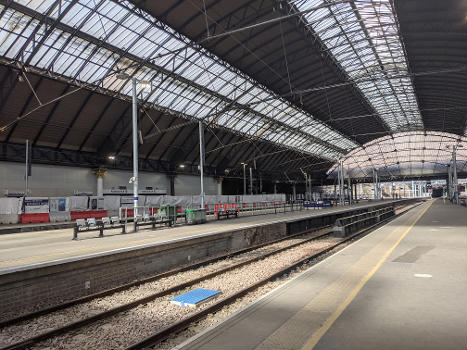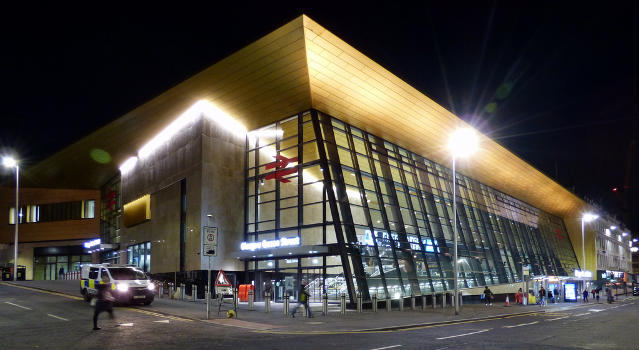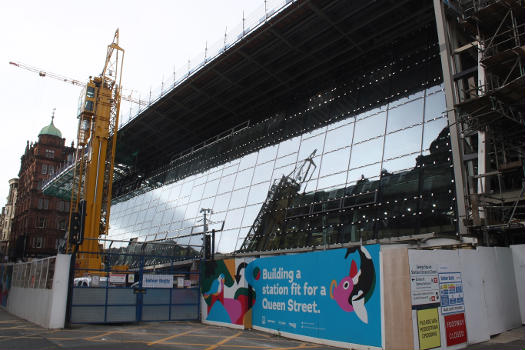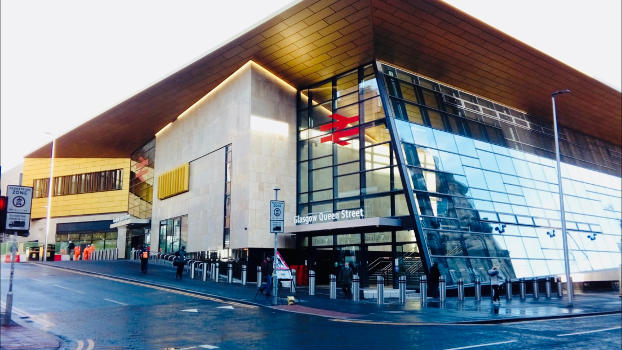General Information
| Other name(s): | Dundas Street Station |
|---|---|
| Completion: | 1842 |
| Status: | in use |
Project Type
| Function / usage: |
Multi-level railroad station |
|---|---|
| Material: |
track hall: Steel structure building: Steel structure |
Awards and Distinctions
| 2021 |
award winner
for registered users |
|---|---|
| 1970 |
track hall
for registered users |
Location
| Location: |
Glasgow, Scotland, United Kingdom |
|---|---|
| Coordinates: | 55° 51' 43.92" N 4° 15' 4.32" W |
Technical Information
Materials
| track hall |
steel
|
|---|---|
| building |
steel
|
Excerpt from Wikipedia
Glasgow Queen Street (Scottish Gaelic:Sràid na Banrighinn) is a city centre railway terminus in Glasgow, Scotland. It is the smaller of the city's two main line railway terminals and the third busiest station in Scotland. The station is situated between George Street to the south and Cathedral Street Bridge to the north, at the northern end of Queen Street adjacent to George Square. Queen Street station serves the Greater Glasgow areas northern towns and suburbs. The station also serves the Edinburgh Waverley shuttle and is the terminus for all inter-city services to destinations in the North of Scotland. The other main city-centre station in Glasgow is Glasgow Central.
History
The station was built by the Edinburgh and Glasgow Railway, and opened on 21 February 1842. In 1865 the E&GR was absorbed into the North British Railway, in 1878 the entire station was redesigned by the civil engineer James Carswell. It became part of the LNER group in 1923.
The climb through the tunnel to Cowlairs is at 1 in 42 and until 1909 trains were hauled up on a rope operated by a stationary engine, although experiments were carried out using banking engines in 1844–48. Three people died in 1928 when a train leaving the station rolled back into another train. Modern diesel trains have no difficulty with the climb.
The adjacent Buchanan Street station of the rival Caledonian Railway closed on 7 November 1966 as a result of the Beeching cuts and its services to Stirling, Perth, Inverness, Dundee and Aberdeen transferred to Queen Street. This caused difficulties with longer trains, as Queen Street is in a confined position between George Square and the tunnel.
In the 1980s, HAST were used on Cross Country and East Coast services run by InterCity, having to use Platform 7 with the end of the train being close to the tunnel mouth.
Services
Queen Street station's platforms are on two levels, with the High Level platforms running directly north-south, and the Low Level running east-west. They are connected by staircases at either end of the Low Level platforms, and by lifts accessible from Platform 7 on the High Level.
High level
The High Level station is the larger of the two levels, and is the terminus for the Edinburgh shuttles and all routes north of the Central Belt run by ScotRail. The high level railway approaches the station building through the Queen Street Tunnel, which runs beneath the Buchanan Galleries shopping centre to the Sighthill area northeast of the city centre. Platforms 1–7 occupy the High Level, Platform 1 being at the western end of the trainshed, and being considerably shorter – it is usually only used for local stopping services. Since the electrification of several of the routes from the High level station (Edinburgh to Glasgow via Falkirk High and to Striling, Dunblane and Alloa) the fleet is largely electric, utalising the new Class 385 trains.
Low level
Platforms 8 and 9 comprise the Low Level station, and it is the most central stop on the North Clyde Line of the Glasgow suburban electric network. Trains run frequently between Helensburgh on the Firth of Clyde, Balloch and suburban Milngavie to Airdrie, on the eastern edge of the Greater Glasgow conurbation and onward to Edinburgh via Bathgate and Livingston. The line is electrified; the fleet operating this route are Class 318s, Class 320s and Class 334s.
Services on the West Highland Line to Oban, Fort William and Mallaig occasionally use the Low Level station when the main route into the High Level is unavailable due to engineering work. As of September 2014, the Fort William to London Euston overnight sleeper also calls here instead of Westerton in the northwestern suburbs, eliminating the need for those travelling between Glasgow & Fort William on the sleeper to change there (alighting only southbound/boarding only northbound), the only locomotive-hauled train to call here.
The Low Level line between High Street, Queen Street and Charing Cross was built before the Glasgow Subway, making it the oldest underground railway in the city. In May–June 2014, work was carried out to redevelop the Low Level platforms, which now have new compliant seating.
Signalling
Queen Street signal box, opened in 1881, was on a gantry spanning the tracks close to the tunnel mouth. It closed on 26 February 1967 when control of the high level station was transferred to a panel in Cowlairs signal box. That box was superseded by the new Cowlairs signalling centre on 28 December 1998. This in turn was abolished in October 2013 and the station is now under the supervision of Edinburgh IECC (which will eventually become the Edinburgh Rail Operating Centre).
The low level station had two signal boxes, 'Queen Street West' and 'Queen Street East'. Both boxes were over the tracks and closed on 8 February 1960. The low level lines came under the control of Yoker Signalling Centre (IECC) on 19 November 1989.
Redevelopment
Minor refurbishment of the station has taken place over in recent years, which has seen the station internally repainted and paved with new flooring, and the CRT screens that displayed train timetables and passenger information were replaced with new LED information boards similar to those in Glasgow Central Station but smaller, in January 2008.
In August 2006 Network Rail revealed that it intended to redevelop Queen Street substantially, making use of the Hanover Street car park area to provide more retail space, and to upgrade the station's entrances, and to provide escalators down to the lower level platforms – at present there are only steep staircases at either end of Platforms 8/9, and lifts which have to be reached using a circuitous route via the main line platforms. More plans were unveiled in September 2011 by Network Rail, along with an announcement that the owner of the Buchanan Galleries shopping mall – Land Securities had been chosen as development partner for the station, which will see the existing 1970s hotel extension which currently fronts the George Square entrance of the station demolished and replaced by a glass atrium. The previous plans of developing the airspace rights above the North Hanover Street car park into an expanded retail and restaurant area will be carried forward – and will form part of the proposed extension to the Buchanan Galleries, which will gain direct access to the station concourse. The redevelopment, which was initially scheduled for completion in June 2019, also includes an extension of the high level platforms to accommodate the longer trains that will be introduced as part of the Edinburgh Glasgow Improvement Programme (EGIP).
In 2009, the Scottish Government announced that the Glasgow to Edinburgh via Falkirk Line would be electrified by 2017. Overhead line electrification lines have been installed on the high level platforms of Queen Street, with Class 380 trains now operating from the station as of December 2017, and Class 385 trains as of Autumn 2018. As part of this work, the High Level station was closed for 20 weeks (from 20 March to 8 August 2016) to allow 1,800 m (5,900 ft) of track in Queen Street Tunnel (and all of the tracks and platforms in the station itself) to be replaced. Services were diverted over various routes during this period, with some trains running to/from the Low Level station and others to/from Glasgow Central station (via Cumbernauld, Coatbridge and Carmyle).
In August 2017, work began on the £100 million redevelopment of the station, which was due to be completed by December 2019, but has now been scheduled to 2020 due to delays in receiving power to go forward with the work.
Proposals
Various schemes to link Queen Street to Glasgow Central station have been considered, as passengers travelling from the north of Scotland to the south and vice versa via Glasgow have to traverse the city centre either on foot or by road. A bus link connects the two stations (which also calls at the city's Buchanan bus station), use of which is free to rail passengers making a cross-Glasgow transfer on a through ticket. Neither of Glasgow's main line terminals is served by the Glasgow Subway, although a moving walkway was installed between Queen Street and the immediately adjacent Buchanan Street subway station during the system's modernisation in 1980, whilst St Enoch station is a short walk from Glasgow Central.
One option to allow cross-Glasgow rail journeys would be Crossrail Glasgow, using a former passenger line (now used only for freight) that links High Street to the Gorbals area. This initiative was reviewed favourably, but progress has been stalled indefinitely as of 2009. Alternative proposals envisage a new city centre station (possibly in a tunnel underneath the city centre) or a light rail / metro system.
Text imported from Wikipedia article "Glasgow Queen Street railway station" and modified on July 23, 2019 according to the CC-BY-SA 4.0 International license.
Participants
Relevant Web Sites
- About this
data sheet - Structure-ID
20033551 - Published on:
04/12/2007 - Last updated on:
31/05/2024












